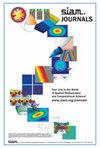Total Generalized Variation on a Tree
IF 2.3
3区 数学
Q3 COMPUTER SCIENCE, ARTIFICIAL INTELLIGENCE
引用次数: 0
Abstract
SIAM Journal on Imaging Sciences, Volume 17, Issue 2, Page 1040-1077, June 2024.Abstract.We consider a class of optimization problems defined over trees with unary cost terms and shifted pairwise cost terms. These problems arise when considering block coordinate descent (BCD) approaches for solving inverse problems with total generalized variation (TGV) regularizers or their nonconvex generalizations. We introduce a linear-time reduction that transforms the shifted problems into their nonshifted counterparts. However, combining existing continuous dynamic programming (DP) algorithms with the reduction does not lead to BCD iterations that compute TGV-like solutions. This problem can be overcome by considering a box-constrained modification of the subproblems or smoothing the cost terms of the TGV regularized problem. The former leads to shifted and box-constrained subproblems, for which we propose a linear-time reduction to their unconstrained counterpart. The latter naturally leads to problems with smooth unary and pairwise cost terms. With this in mind, we propose two novel continuous DP algorithms that can solve (convex and nonconvex) problems with piecewise quadratic unary and pairwise cost terms. We prove that the algorithm for the convex case has quadratic worst-case time and memory complexity, while the algorithm for the nonconvex case has exponential time and memory complexity, but works well in practice for smooth truncated total variation pairwise costs. Finally, we demonstrate the applicability of the proposed algorithms for solving inverse problems with first-order and higher-order regularizers.
一棵树上的总体变化
SIAM 影像科学期刊》第 17 卷第 2 期第 1040-1077 页,2024 年 6 月。 摘要.我们考虑了一类定义在具有一元代价项和移位成对代价项的树上的优化问题。这些问题是在考虑用块坐标下降(BCD)方法解决具有总广义变异(TGV)正则或其非凸广义的逆问题时出现的。我们引入了一种线性时间还原法,可将移位问题转化为非移位问题。然而,将现有的连续动态编程(DP)算法与还原法结合起来,并不会产生能计算类似 TGV 解的 BCD 迭代。要解决这个问题,可以考虑对子问题进行箱约束修改,或者对 TGV 正则化问题的代价项进行平滑处理。前者会导致移位和盒式受限子问题,为此我们提出了一种线性时间还原为无约束对应问题的方法。后者自然会导致具有平滑单值和成对成本项的问题。有鉴于此,我们提出了两种新颖的连续 DP 算法,可以解决具有片断二次单项式和成对代价项的(凸和非凸)问题。我们证明,凸情况下的算法具有二次最坏情况时间和内存复杂度,而非凸情况下的算法具有指数时间和内存复杂度,但在实践中对于平滑截断的总变化成对成本效果很好。最后,我们展示了所提算法在解决具有一阶和高阶正则的逆问题时的适用性。
本文章由计算机程序翻译,如有差异,请以英文原文为准。
求助全文
约1分钟内获得全文
求助全文
来源期刊

SIAM Journal on Imaging Sciences
COMPUTER SCIENCE, ARTIFICIAL INTELLIGENCE-COMPUTER SCIENCE, SOFTWARE ENGINEERING
CiteScore
3.80
自引率
4.80%
发文量
58
审稿时长
>12 weeks
期刊介绍:
SIAM Journal on Imaging Sciences (SIIMS) covers all areas of imaging sciences, broadly interpreted. It includes image formation, image processing, image analysis, image interpretation and understanding, imaging-related machine learning, and inverse problems in imaging; leading to applications to diverse areas in science, medicine, engineering, and other fields. The journal’s scope is meant to be broad enough to include areas now organized under the terms image processing, image analysis, computer graphics, computer vision, visual machine learning, and visualization. Formal approaches, at the level of mathematics and/or computations, as well as state-of-the-art practical results, are expected from manuscripts published in SIIMS. SIIMS is mathematically and computationally based, and offers a unique forum to highlight the commonality of methodology, models, and algorithms among diverse application areas of imaging sciences. SIIMS provides a broad authoritative source for fundamental results in imaging sciences, with a unique combination of mathematics and applications.
SIIMS covers a broad range of areas, including but not limited to image formation, image processing, image analysis, computer graphics, computer vision, visualization, image understanding, pattern analysis, machine intelligence, remote sensing, geoscience, signal processing, medical and biomedical imaging, and seismic imaging. The fundamental mathematical theories addressing imaging problems covered by SIIMS include, but are not limited to, harmonic analysis, partial differential equations, differential geometry, numerical analysis, information theory, learning, optimization, statistics, and probability. Research papers that innovate both in the fundamentals and in the applications are especially welcome. SIIMS focuses on conceptually new ideas, methods, and fundamentals as applied to all aspects of imaging sciences.
 求助内容:
求助内容: 应助结果提醒方式:
应助结果提醒方式:


